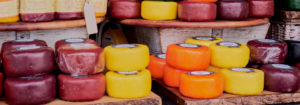6 Tips For Using Cheese Wax
Did you know? Coating your cheese in wax stabilizes moisture in the desired range to protect your cheese as it ages.
Follow our six tips for using cheese wax:

1. Gather Your Cheese Waxing Supplies
Coating your cheese in wax only requires a few supplies, so be sure to have them in place before you begin.
Here’s what is needed to wax cheese:
- Cheese to wax: Many hard kinds of cheese are suitable for waxing, including Swiss, cheddar, Gruyère and Colby.
- A storage container: Choose a container to store the cheese once waxed so you can control the temperature and moisture conditions.
- A wax-safe thermometer: Use a wax-safe thermometer to monitor the temperature during preparation and coating.
- A block of cheese wax: Blended Waxes sells cheese wax in 10-pound slabs available in a variety of colors from red to yellow.
2. Maintain a Constant Temperature
Melt the wax in the container and monitor the temperature with your thermometer. Maintaining a consistent temperature is very important to provide an even coating of wax on the cheese. We recommend keeping the melted wax temperature for our waxes between 160° and 170℉, but follow your cheese’s specific preparation instructions to avoid its particular melting temperature.
3. Remove Excess Moisture
Removing excess moisture from your cheese before dipping it into the wax is important to help the wax adhere to the cheese. Use a lint-free cloth and gently pat the cheese dry before dipping. Make sure there is no residue left on the cheese to make the wax easy to remove later.
4. Be Mindful of Mold
One of the benefits of using cheese wax is protection from mold. However, if there is mold on the cheese before you dip it in the wax, it will continue to grow while the cheese ages. Use a brine or vinegar wash to clean and remove mold from your cheese before coating. The high concentration of salt or acid works to remove the mold safely without compromising the cheese’s taste or texture.
5. Dip for Application
We’ve found hand-dipping cheese in the wax is the easiest coating method:
- Start by dipping one-half of the cheese in the wax.
- Let the excess wax drip off before setting it down on the unwaxed side to allow the wax to harden.
- Once the first half of wax is hardened, dip the unwaxed half of the cheese in the wax.
- Repeat the process for the uncoated half.
Do not let your skin come into direct contact with hot wax. Wear protective gloves, clothing and goggles to avoid burns or discomfort.
6. Use Proper Storage
Once coated in wax, store your cheese in a cool area with the proper moisture levels, and avoid direct sunlight or other environmental hazards, like areas close to cleaning agents or chemicals. Most cheeses age well in a room that is 52 to 56°F and 85 percent moisture, but ideal temperatures vary among types. Check under the waxed cheese weekly for mold growth and rotate if necessary. If done correctly, your waxed cheese should last years to come until you’re ready to use it.
Once your waxed cheese is ready to eat and you cut into it or otherwise remove the wax coating, store it in the refrigerator to retain flavor and stay mold-free.
Shop Cheese Wax From Blended Waxes
At Blended Waxes, we specialize in custom wax blending solutions while adhering to strict quality standards and keeping your budget and goals in mind. We can help with material storage at our bulk terminal facility or provide private label manufacturing for your company’s branding.
We have several types of cheese wax to fit your cheesemaking, including:
- BW-100F Series: This is a durable, versatile cheese wax with light coloring. The minimum congealing point is 141°F.
- BW-100J Series: This series is a flexible, light-colored wax ideal for beginners. The minimum congealing point is 136°F.
- BW-100K Series: This is a widely used cheese wax across industries and applications. The minimum congealing point is 140°F.
- BW-100L Series: Cheesemakers on a budget love this wax, as it is versatile and economical. The minimum congealing point is 138°F.
Depending on the wax you choose, color options include brown, yellow, black, cheddar, white, purple, red, green and orange. You can also choose a clear wax to showcase the cheese’s natural coloration.
All Blended Waxes cheese waxes are compliant with applicable federal regulations and are available in slabs.

